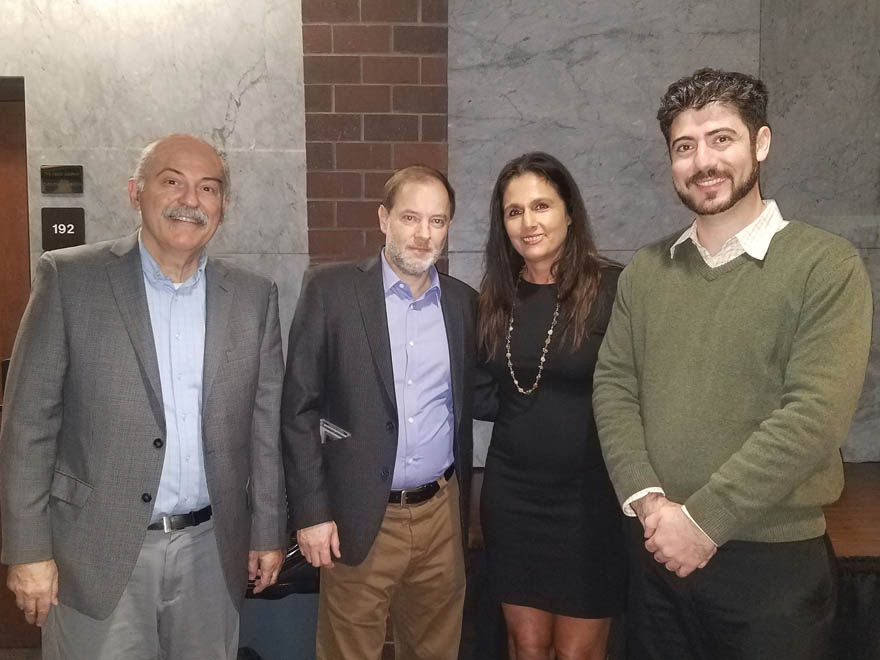
Photo: Christine Pambukyan
Annie Rubio
Editor
Few people would stop to stare at a pile of rocks scattered across a field. Even fewer would be able to distinguish that a historic monastery used to exist there. Scottish explorer Steven Sim has spent nearly 40 years doing just that. From his days as an architecture student, he made the startling discovery that many of the historic sites in Turkey are actually Armenian. However, very few have been left standing. Five years ago, Sim and producer Ani Hovannisian met by happenstance in Turkey and began a productive collaboration into research on the Armenian heritage in Turkey.
On Tuesday, November 13, the Armenian Studies Program organized a talk by Sim and Hovannisian on “The Hidden Map of Historic Armenia,” as part of its Fall Lecture Series. The standing room only audience was treated to a special preview of the video The Hidden Map. The video follows Sim on his journey throughout Turkey and also discusses how the pair met. The video also focused on Hovannisian’s journey to discover her own ancestral roots in historic Armenia.
The Hidden Map showed how Sim began his trip to Turkey searching for Armenian historical monuments. His journey began when he was searching for the Khtzkonk Monastery in eastern Turkey. Sim’s travel-guide noted that the historic complex had five churches. However, Sim found only one structure remaining when he visited, a mere 10 years after the guide was published. This led him on a decades-long search for other historic Armenian sites, only to discover that most were in ruins.
One day, Sim met Ani Hovannisian in an abandoned Armenian home. The pair struck up a friendship and began searching for Hovannisian’s ancestral village of Bazmashen, in the region of Kharpert. Her family memoirs detailed the many houses and schools in the region, and that there was no Turkish presence in the village. However, when they finally visited the site there was little trace of the village, with only a few rocks remaining, and a few shards of red pottery.
Some Armenian monasteries are being renovated and turned into museums. According to Sim, “there is nothing intrinsically wrong with that, but when the curator is the Turkish state, it can lead to unfortunate things.” These museums are portraying a skewed vision of historic Armenia.
As Sim explained, “there is a policy in Turkish academia to misrepresent, or just ignore, Armenian objects.” He visited an Armenian graveyard near Van that had been misreported as a stoneworking area by Turkish archaeologists. When comparing the actual location to the historical drawing of the area, it was clear that the area was not correctly drawn and certain gravestones were misrepresented, or just left out completely.
“It’s not just big monuments that Turkey has destroyed, it’s small things as well,” stated Sim. He referenced a statue of King Gagik Bagratuni, which had previously been held in the Ani museum. It was too large to evacuate, so the Armenians buried it in hopes of saving the statue. Although it was later found, it disappeared again enroute to a museum in Ankara. Later in the 1990s, only a piece of the shoulder remains.
Sim and Hovannisian hope that The Hidden Map will encourage the preservation and recognition of Armenian culture and heritage in Turkey. Because of the denialist policy and lack of preservation of Armenian history, many feel scared to embrace their heritage. The Turkish government has renamed many villages to remove the Armenian names, and actively destroyed historic monuments. Even so, Sim continues to travel throughout Turkey and has taken over 100,000 photos of historic Armenian artifacts and monuments.
“Although Armenia today may not exist as a real place in Eastern Turkey, and may no longer ever be recognized as a place that existed in academic literature, I’m still going to continue to go there,” concluded Sim.
 Hye Sharzhoom Armenian Action
Hye Sharzhoom Armenian Action